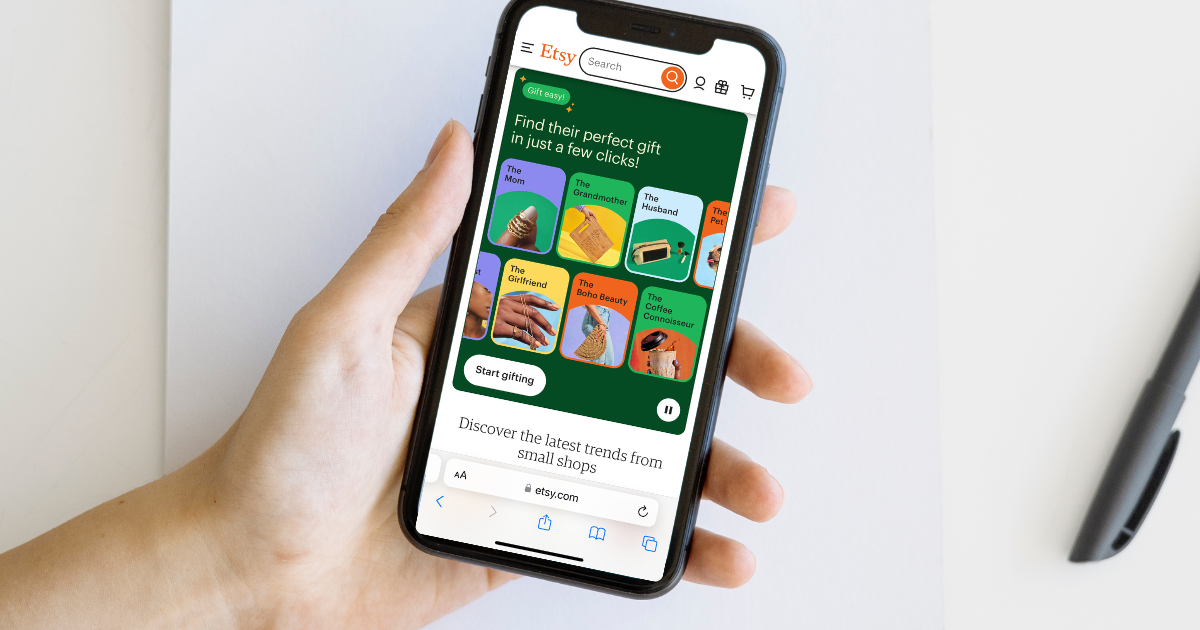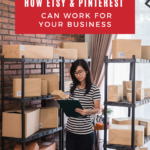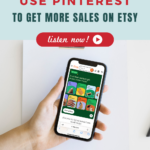Pinterest and Etsy have had a unique relationship over the years—a bit of a love-hate relationship. Should you use Pinterest for Etsy? To dive deeper into this topic, Etsy success coach, Dylan Jahraus, is here to help us understand how Pinterest and Etsy can work together for your business. If you’re an Etsy seller or know someone who is, please pass along this interview.
Today’s episode is brought to you by Pin Generator. Pin Generator is the Pinterest marketing tool that saves you tons of time creating and scheduling pins. You can input any URL into Pin Generator, and it will generate pins using images and content from that URL. Best of all, you can create your own dynamic templates to suit your brand perfectly. Check out Pin Generator’s awesome AI features that make creating unique Pinterest content a breeze. Use the code SPM, short for Simple Pin Media, to get 20% off any of the plans this week only.

This post contains affiliate links, which means if you make a purchase through these links, I may receive a small commission at no extra cost to you. Click here to read my full disclosure policy.
Etsy in 2024
Kate: Dylan, welcome to the Simple Pin Podcast!
Dylan: Thanks for having me, Kate! I’m excited to be here.
Kate: I’m thrilled to chat with you! We connected after I was on your podcast, and since then, I’ve been thinking about the current state of Etsy, especially in light of our economic landscape and how challenging it is for small business owners to gain traction these days. Etsy is a whole community of small business owners, and you work with them daily. So, can you share what you’re hearing from your students and community about the current landscape for Etsy sellers?
Dylan: Yes, there have been a lot of changes on Etsy, particularly in the last year. They made updates to product categories in July and are changing the algorithm again as of October 1st. There are a lot of misconceptions circulating; some people think, “Okay, I’m not even going to try.” When people hear about changes, they often assume it’s bad news and use it as an excuse to give up. In reality, these changes make the Etsy landscape more competitive in a positive way because there are now more ways to compete.
Etsy has introduced some new categories—sourced or handpicked by sellers—allowing people to curate products. This was previously not allowed; sellers would get kicked off for that. It opens up a whole new playing field for those who may not be super crafty but have an eye for design and want to ship high-margin physical products. This could be a faster-growing arena on Etsy. So, these changes are exciting, and they mean that skill will win.
Kate: When did Etsy actually start?
Dylan: Oh my gosh, I think it was around the early 2000s—over 15 years ago.
Etsy Sellers
Kate: So, we’ve seen this movement of sellers over the years, from the original creators to those who are entering the market now. What do you find regarding the trajectory of Etsy sellers? Are there a lot of new sellers entering the scene, or do you see more seasoned ones adapting to these changes?
Dylan: I would say there are three main buckets of sellers. The first is the OGs—original sellers who have been on Etsy for at least seven to nine years. They’ve seen all the changes, and right now, they’re either relying on what worked for them in the past, which is leading to a decrease in sales, or they’re adapting to maintain their position.
The second bucket includes people who started in 2020. They thought, “I have all this time; I’ll throw some things up as a side hustle.” Their shops might still be open, but they may have only made 20 sales because they didn’t prioritize their businesses seriously.
The third bucket consists of new sellers starting after 2022, particularly as stimulus checks dried up. They are looking at Etsy much more strategically because they need to make extra income to maintain their lifestyle. So, there’s a new wave of people coming in with a more serious approach.
Kate: That’s fascinating! With these new sellers, how do you help them overcome the hurdles of marketing their products? There seems to be a tension between their passion for the product and the struggle with marketing.
Know Your Audience!
Dylan: This is one of the biggest slip-ups newer sellers make. They start with the product and then ask, “Who’s going to buy it?” They’re essentially standing on a street corner trying to sell something without knowing their audience. We need to reverse-engineer this process. It’s fine to start with a product, but it’s essential to focus on the customer first.
Who are the people who will buy consistently? We don’t just want to sell to as many people as possible; we want to target our marketing. Then we can determine where those customers spend their time—whether on Facebook, Instagram, or Pinterest—and prioritize that platform.
The Best Platforms For Etsy Conversions
Kate: Out of all those platforms, where do you see most Etsy sellers finding success in their marketing?
Dylan: When it comes to social media, you can easily get lost in the rabbit hole. You have to be intentional about your goals. Many platforms focus on views or followers, which don’t necessarily translate into sales. The best platforms for actual conversions are those where customers go expecting to click on something and leave, like Facebook and Pinterest.
Facebook works well for short-term engagement; people often go there looking for recommendations and are quick to purchase. Pinterest, on the other hand, is a long game but equally important. Users go there expecting to click through, so the quality of traffic can be very high.
The Pinterest and Etsy Relationship
Kate: I rarely leave Instagram to check out products, but I do find myself clicking off Facebook. That’s a great point. Let’s talk a little about Pinterest and Etsy relationship. There have been rumors that Pinterest doesn’t favor Etsy sellers. What’s your perspective on that?
Dylan: We really need to squash the idea that Etsy doesn’t want you using Pinterest. In fact, they love when you bring in outside traffic! Etsy actually has a share and save program where they give special links to reduce transaction fees for external traffic. They want that influx.
For Etsy sellers, social media can be intimidating. Facebook feels very personal, while Pinterest allows for more anonymity, making it feel safer. It’s also easier to engage with Pinterest when you’re mentally exhausted. You can still contribute to your marketing without needing to create polished content.
Kate: Absolutely! Pinterest has such a long game, and as they lean into e-commerce, they’re working to shorten the time from discovery to purchase. It’s exciting for Etsy sellers to get those integrations.
Related: Using Pinterest for Etsy Traffic
Tracking Analytics
Kate: So, how can Etsy sellers track their analytics and the effectiveness of their Pinterest marketing?
Dylan: Etsy sellers can see their traffic sources right in their dashboard, specifically under external traffic from social media. You can track the number of visits your shop receives from Pinterest, as well as which listings get the most traffic. You can analyze the images and SEO behind those listings to improve your overall strategy.
Kate: That’s amazing! It sounds like you’ve learned a lot from your experiences on Pinterest.
Dylan: Absolutely! By focusing on what’s working, you can double down on those successful listings and images. Having a repeatable process is invaluable for business growth.
Kate: I agree—casting a wide net often leads to doing too much and getting less done. Would you say that you guide your students to focus on specific platforms?
Dylan: Marketing can be tricky for solo entrepreneurs. If someone doesn’t enjoy a particular platform, they won’t engage with it effectively. So, I make recommendations based on their comfort level. If they’re open to it, I suggest prioritizing both Facebook and Pinterest equally.
The Future of Etsy
Kate: Looking ahead, where do you see Etsy going in the next few years?
Dylan: Etsy is still the fastest place to build a brand. They’re actively working on customer loyalty initiatives, like the Deals and Drops program for Etsy Insiders. They’re investing in marketing strategies that benefit both sellers and buyers, which is promising for the future.
Kate: There’s always been a conversation about third-party hosting like Etsy versus having your own website. Do you see that tension still existing?
Dylan: Yes, many sellers understand the importance of diversifying. While Etsy drives traffic, having your own website allows for greater control and potential resale value. Both options are beneficial at different stages of a seller’s journey.
Kate: What advice would you give to someone with a product idea who’s considering starting an Etsy shop today?
Dylan: The biggest regret I hear from those who wait is that they didn’t start sooner. You’ll often realize the opportunity cost of not starting is significant. The speed at which you can make decisions will reflect your business’s potential success. Take that first step, and you won’t regret it.
Kate: Great reminder! With the current uncertainty in small business ownership, getting started is crucial. Where can people connect with you for more information on becoming an Etsy seller?
Dylan: You can book a call with me to see if you qualify for our program, The Ultimate Etsy Course. Definitely check out our YouTube channel, where we have hundreds of free videos and resources. Many people have found success just by watching our content. You can also find me on Instagram if you want to chat in the DMs.
Kate: Thank you, Dylan, for joining me today! I hope anyone thinking about starting an Etsy shop will hop over to your resources and get started before it’s too late.
Dylan: Thank you, Kate! This was so fun!
More Pinterest Marketing Resources:
Watch: Etsy Sellers on Pinterest – Top 3 Tips








